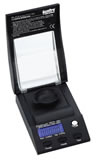How a Gem Lab Looks at Diamonds
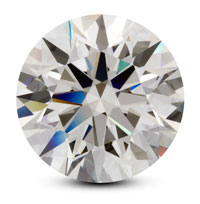 We often emphasize the importance of having an appraisal from a gemologist who examines the jewelry in a gem lab.
We often emphasize the importance of having an appraisal from a gemologist who examines the jewelry in a gem lab.
The “gem lab” is not really a place but a set of equipment. Here are some of the most important instruments and how the appraiser uses them to determine quality and valuation.
Master Stones (Color)
 Diamond is the most popular gemstone, so instruments for evaluating diamond quality, especially the 4 Cs, are essential.
Diamond is the most popular gemstone, so instruments for evaluating diamond quality, especially the 4 Cs, are essential.
A set of 9 master stones is used to grade the color of diamond. These sets, available from GIA, have diamonds in color gradations labeled to correspond to the GIA color grades. The appraiser matches the subject diamond to one in the set. A difference of one color grade can mean thousands of dollars, so the accuracy of the master set, consistency of lighting, and the care of the appraiser are all crucial. (Master sets made of CZ — cubic zirconia, or fake diamond — also exist, but professional gemologists do not consider them reliable.)
Diamond Light Box (Color)
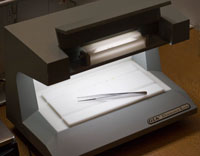 Since the presence of even the slightest tinge of color is what’s at issue in color grading, the influence of ambient colors must be minimized. If the system is to be standard, the light and viewing conditions must be consistent.
Since the presence of even the slightest tinge of color is what’s at issue in color grading, the influence of ambient colors must be minimized. If the system is to be standard, the light and viewing conditions must be consistent.
The diamond light box creates that standard environment: it simulates ideal daylight and reduces glare and reflection from colors in the room, creating optimal conditions for comparing a diamond with the master set of graded stones.
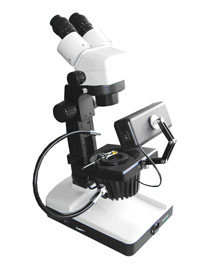 Gem Microscope (Clarity)
Gem Microscope (Clarity)
The microscope allows the appraiser to detect inclusions in the stone. Based on inclusions, the appraiser grades the clarity of the diamond, preferably based on the GIA grading system. In some lab reports, inclusions are plotted on a diagram of the stone.
Examination of the stone will also reveal treatments done to conceal inclusions, such as laser drilling or fracture filling. These “enhancements” significantly lower the value of the diamond and should be reported on the appraisal.
Clarity grading is determined using 10-power magnification. A jeweler’s loupe magnifies to 10X, but a gem microscope is preferable because the stone appears against a black background, is lit from the sides, and is shielded from reflections, allowing a clearer, more accurate reading.
A gem microscope also is capable of higher magnification, usually up to 30X.The higher powers may be used to read laser inscriptions on thin girdles, or to examine laser drill holes that could weaken the stone.
Carat/Gram Scale (Carat Weight)
An electronic scale measures weight in carats, grams, or pennyweight, so it can be used for weighing stones (in carats) or metals (in grams or pennyweight).
Proportionscope (Cut)
Cut proportions — such as crown angle, pavilion depth, table diameter and girdle thickness — account for fully 50% of a diamond’s value. The proportionscope is an inexpensive device for determining proportions in round brilliant stones, the most popular shape.
This instrument projects an enlarged silhouette of the subject diamond onto a diagram showing the proportions of a well-cut diamond. By comparing the two, a trained gemologist can measure the cut proportions of the diamond in question and determine the quality of the diamond’s cut.
The proportionscope can be used only with loose gems. For mounted stones, the appraiser must estimate the cut grade. To insure the greatest accuracy, labs such as GIA will grade only loose stones.
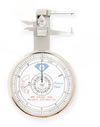 Leveridge Gauge
Leveridge Gauge
This is a highly accurate device that measures stones to one tenth of a millimeter. The stones can be either mounted or unmounted.
Thermal Diamond Tester
 Diamond is a great heat conductor, so thermal diamond testing is a quick way to distinguish diamond from look-alikes, such as moissanite or CZ.
Diamond is a great heat conductor, so thermal diamond testing is a quick way to distinguish diamond from look-alikes, such as moissanite or CZ.
Metal Testing Acids
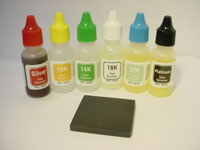 Often the karatage of gold is not marked on the jewelry, or the type of metal may even be in question. To test the metal, the appraiser scrapes the item against an abrasive surface (the black square in the picture), where the metal leaves a trace. The appraiser then applies various acids to the trace to see which dissolves the metal.
Often the karatage of gold is not marked on the jewelry, or the type of metal may even be in question. To test the metal, the appraiser scrapes the item against an abrasive surface (the black square in the picture), where the metal leaves a trace. The appraiser then applies various acids to the trace to see which dissolves the metal.
FOR AGENTS & UNDERWRITERS
Visual inspection, without using gem lab equipment, is inadequate for properly identifying gemstones and simulants. In one TV investigation, half the jewelers consulted mistook a simulant (moissanite) for diamond.
Most jewelry retailers have no formal gemological training. An insurance industry study found that only 21% of jewelers writing insurance appraisals were graduate gemologists or the equivalent.
The most reliable insurance appraisal is a JISO 78/79, prepared by a trained gemologist (GG, FGA, or equivalent), with additional insurance appraisal training. One course offering such additional training is the Certified Insurance Appraiser™ (CIA) course of the Jewelry Insurance Appraisal Institute, Oakland, CA.
FOR ADJUSTERS
If you do not have a detailed appraisal from a trained gemologist appraiser, use JISO 18 to analyze information from the documents you have. This is especially helpful if you’re faced with a “narrative” appraisal. JISO 18 allows you to order the information from other documents to see what details may be missing.
Use descriptive data from the appraisal and other documents, rather than the valuation, to price a replacement.
Be sure to note the mention of any enhancements/treatments, such laser drilling and fracture filling, as these significantly affect value.
For all high-value diamond jewelry, use every means possible to be sure the diamond is not synthetic, enhanced, or an out-and-out fake. A mistake in this regard would result in serious overpayment.
For more information on insurance appraisals, view the video at https://www.jcrs.com/appraisal_presentation/WhatMakesAGoodAppraisal.pps
Next month we’ll cover the more advanced tools used in a well-equipped lab.
©2000-2025, JCRS Inland Marine Solutions, Inc. All Rights Reserved. www.jcrs.com

